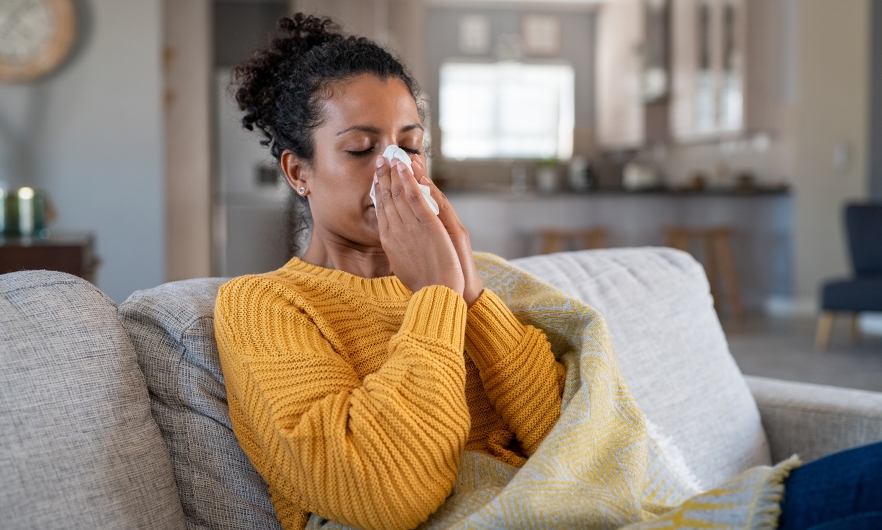What to Expect From This Year’s Flu Season

Thanks to COVID-19 safety measures like mask-wearing and social distancing, there were very few flu cases compared to years past.
However, as life returns to “normal,” experts worry that we’ll see a resurgence of cases among vulnerable populations. Virologist Andy Pekosz, PhD, provides insight on what to expect as we head into prime flu season.
This Q&A is adapted from an October 20 episode of Public Health On Call.
There was virtually no flu season last year. Why was that?
Last year, we didn't see the flu, but we also didn't see a number of other respiratory viruses. We didn't see rhinoviruses that cause the common cold. We didn't see respiratory syncytial virus (RSV), which is a virus that infects kids and can cause some rather severe respiratory illnesses.
We had more public health interventions in place last year. Additionally, we had a higher level of immunity in the population. In any given year, there's less of us that are susceptible to flu than there were that were susceptible to COVID-19. So public health interventions, plus this immunity in the population, helped us keep down the cases of flu and RSV.
Do experts think we’ll see an increase in flu cases this year compared to last?
Yes, there's a good chance that we will see the flu this year.
We don't have as many strict public health interventions as we did [last year], and we’ve seen a big surge in rhinovirus cases and common colds. We have also seen surges in RSV, so the next thing we expect to see is the flu, because that's the way they normally follow each other in a regular respiratory season.
How does sickness from the flu compare to COVID-19?
Influenza does cause a significant amount of disease in the population. It pales with respect to what happened with COVID-19, but it’s [still] dangerous, particularly for the [very] young and the elderly.
A resurgence of flu, on top of dealing with COVID-19 levels, represents two really significant challenges to us in terms of the people working on respiratory viruses.
How long can the flu virus live on surfaces?
Influenza can live longer on surfaces compared to SARS-CoV-2, the virus that causes COVID-19, and you can pick it up from surfaces. Hand-washing has been documented to work for influenza. The data on hand-washing and COVID-19 is a little bit mixed because SARS-CoV-2 seems to really prefer the respiratory route for spread.
When should I get my flu shot?
Now is the perfect time to get your influenza shot. If we expect a strong flu season, it'll be an early flu season.
Can I get a flu shot at the same time as the COVID booster shot?
Absolutely. CDC guidelines say you can get both at the same time. There should be no issues whatsoever in terms of your reaction to either shot.
Is the flu shot protective against COVID-19?
No. The virus that causes COVID and the viruses that cause influenza are very, very different on so many different levels.
Do COVID-19 tests detect the flu virus?
No.
With COVID-19 also spreading, will we be able to accurately track flu cases?
The CDC monitors something called “influenza-like illness.” That accounts for people who report a certain set of symptoms: coughs, colds, fevers, sneezing, those kinds of things.
Initially when COVID-19 appeared, this ILI indicator went through the roof—not because we had lots of influenza, but because people were reporting COVID-19 symptoms and those were being classified as influenza symptoms. I worry now we're going to see the same sort of level of confusion.
Is it important to determine whether you have the flu or a COVID-19 infection?
Absolutely. The course of treatment is completely dependent upon what you have. You have to be tested with an accurate test to know what you're infected with.
What should I do if I or my child tests positive for the flu?
I would argue if you're positive for the flu, you should stay home just as you would stay home if you were positive for COVID-19. You could spread the flu to other people and cause a significant amount of disease, particularly in younger populations.
How did experts determine which strains of the flu to protect against in the vaccine this year?
The meetings were very different this year, with fewer choices among strains. Interestingly, there’s some data out there that a couple of strains of flu may have died out because we haven't detected them in six to nine months. These public health interventions have really potentially decimated some strains of flu.
But there have been a few strains of flu detected in other parts of the country and in other parts of the world, and vaccines have been made based on those guesses.
So what we really are going to be looking for, particularly in October and November, is what do those first few strains in the U.S. look like? Do they match the vaccine, and are they A or B influenza? B is the one that we're a little bit more concerned about because it circulates in kids to a higher extent, and that’s where we think the greatest lack of immunity will be.
Andrew Pekosz, PhD, is a professor in Molecular Microbiology and Immunology with a joint appointment in Environmental Health and Engineering at the Johns Hopkins Bloomberg School of Public Health.





